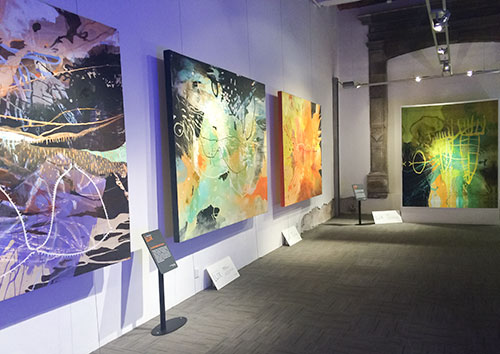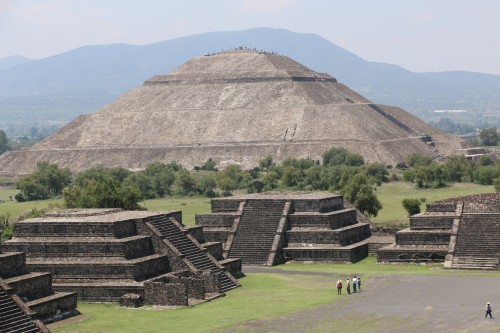Posts by: James Dacey
Going underground to discuss alien life
By James Dacey
“Genuinely, it could be our generation that first finds life on another planet,” declared astrobiologist Lewis Dartnell last Thursday during a public talk in London. Dartnell was speaking about the possibility of life beyond Earth and what those organisms might be, based on our understanding of life here on Earth. The choice of venue – a pedestrian tunnel near King’s Cross Station bathed in neon lights – brought an appropriate alien vibe to the evening. Part of the reason for choosing the site is because if humans were to one day colonize Mars we would need to spend the first few years living underground to avoid the lethal radiation.
Physics World special report on Mexico is out now
By James Dacey
Today is Mexico’s Independence Day, marking the Grito de Dolores – the day in 1810 when the Roman Catholic priest Miguel Hidalgo called on his congregation in the small Mexican town of Dolores to revolt against the Spanish colonial government. This “Cry of Dolores” is seen as the flash point that triggered the Mexican War of Independence.
Modern-day Mexico is still a place with its fair share of turmoil, as the government faces increasing pressure over its inability to deal with drugs, violence and corruption. One area that is starting to look more positive, however, is Mexico’s science base – the administration of president Enrique Peña Nieto has vowed to double Mexico’s investment in science and technology to 1% of GDP and has already sanctioned increases in 2013 and 2014.
To shine a light on what the Mexican physics community is up to, this month sees the publication of a new free-to-read Physics World special report on physics in Mexico. We believe that physicists in Mexico are doing engaging work that deserves to be more widely known. In choosing our coverage for the report, we have not only focused on the challenges for the Mexican community, but also hope to give you a flavour of the rich culture and geography of this most colourful of countries.
Playing the cosmic piano
By James Dacey
Researchers at CERN are renowned for their musical side-projects. Notable examples include the album released by scientists at the ATLAS detector in 2010, and the “Large hadron rap“, which currently has almost 8 million hits on YouTube. And of course don’t forget the pop-star-turned-physicist Brian Cox who had the UK chart-topping hit “Things can only get better” in the 1990s with his band D:Ream.
Following in this musical tradition, a duo of Mexican researchers has invented a “Cosmic Piano” inspired by the technologies used at the ALICE particle detector at the Large Hadron Collider (LHC). The instrument’s inventors Arturo Fernández Téllez and Guillermo Tejeda Muñoz hold positions at CERN and the University of Puebla in Mexico. They hope the device can demonstrate both the science and the art of the work being carried out at particle-physics facilities.
View all posts by this author | View this author's profile
Keep it brief
By James Dacey
“Brevity is a great charm of eloquence,” said the great Roman orator Cicero. A new study published today suggests that researchers would be wise to follow Cicero’s advice when it comes to choosing a title for their next academic paper. Data scientists at the University of Warwick in the UK analysed 140,000 papers and found that those with shorter titles tend to receive more citations.
Similar studies have been carried out in the past leading to contradictory results. But Adrian Letchford and his colleagues have used two orders of magnitude more data than previous investigations, looking at the 20,000 most cited papers published each year between 2007 and 2013 in the Scopus online database. Publishing their findings in Royal Society Open Science, Letchford’s group reports that papers with shorter titles garnered more citations every year. Titles ranged from 6 to 680 characters including spaces and punctuation.
View all posts by this author | View this author's profile
Sandpit physics
By James Dacey
When you think of cutting-edge experimental physics, you might picture the grandiose detectors of the Large Hadron Collider (LHC), or perhaps a lab-coat-wearing scientist hunched over a shiny new microscope. Sometimes, however, all you need is a bucket of sand, a balloon and a pin.
View all posts by this author | View this author's profile
Women in graphene
By James Dacey in Manchester
 Today is the third day of Graphene Week, a conference at the University of Manchester devoted to the fundamental science and applications of 2D materials. While many of the talks require a PhD in materials science to even understand the title (I for one am struggling), one session taking place this evening has the refreshingly simple title: Women in Graphene. Intrigued, I caught up with the session organizer Katarina Boustedt from Chalmers University of Technology in Sweden.
Today is the third day of Graphene Week, a conference at the University of Manchester devoted to the fundamental science and applications of 2D materials. While many of the talks require a PhD in materials science to even understand the title (I for one am struggling), one session taking place this evening has the refreshingly simple title: Women in Graphene. Intrigued, I caught up with the session organizer Katarina Boustedt from Chalmers University of Technology in Sweden.
Graphene Week is an annual event organized by the Graphene Flagship, the EU’s biggest ever research initiative with a budget of €1 billion. As promoting equality is a key part of the Flagship’s mission, Boustedt has launched this initiative to support women working in 2D materials research. Tonight’s two-hour session is designed to start the conversation and find out the types of support that women researchers would like.
View all posts by this author | View this author's profile
On top of the volcano – part one
By James Dacey at Sierra Negra, Mexico
Friday was the final full day of the Physics World Mexican adventure and we ended with a breathtaking experience, quite literally.
Matin and I rose early in Puebla to travel over a hundred kilometres east to the ominously named Sierra Negra volcano. This extinct beast is home to two of Mexico’s finest astrophysics facilities.
View all posts by this author | View this author's profile
Examining precious artefacts without breaking them
By James Dacey in Mexico
From pre-Hispanic archaeological treasures to the Modernist paintings of Frida Kahlo and Diego Rivera, Mexico is brimming with cultural artefacts. Yesterday I visited a centre at the National Autonomous University of Mexico (UNAM) that has developed techniques for investigating precious objects without damaging them.
View all posts by this author | View this author's profile
Particle-physics lab beneath a Mexican pyramid
By James Dacey in Mexico
Yesterday was day three of the Physics World Mexican adventure and it turned out to be a really exciting 24 hours. Matin Durrani and I visited Teotihuacan – the “City of the Gods”– located 30 miles north-east of Mexico City. We were there to witness some of the closing moments of a 15-year particle physics experiment designed to “see” inside the Sun Pyramid, the world’s third biggest pyramid by volume.
View all posts by this author | View this author's profile
A bright light in Mexico City’s historic centre
 By James Dacey in Mexico City
By James Dacey in Mexico City
When you visit an unfamiliar city, you can often discover some hidden gems by just wandering the streets with your eyes wide open. This is what happened to Physics World editor Matin Durrani and me yesterday here in Mexico City when we stumbled across the Museo de la Luz (Museum of Light) in the backstreets of the historic city centre.
Located in an old Jesuit college with a beautiful courtyard, the exhibits are spread over three floors covering a wide spectrum of themes, from human vision to the history of the theories of light. What I loved about the place is that it really did offer something for everyone. Too often I find that museums can be great for kids or great for the type of serious adult who loves to leaf through tea-stained archives. El Museo de la Luz manages to hit a sweet spot, being informative and interactive but not too whizz-bang – that is certainly not what I needed yesterday with this jetlag!
View all posts by this author | View this author's profile

